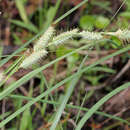Comments
provided by eFloras
Grazed or severely disturbed plants of Carex glaucescens sometimes flower in August or later; these plants have condensed inflorescences and androgynous terminal spikes.
- license
- cc-by-nc-sa-3.0
- copyright
- Missouri Botanical Garden, 4344 Shaw Boulevard, St. Louis, MO, 63110 USA
Description
provided by eFloras
Culms to 120 cm. Leaves: sheaths glaucous, fronts strongly veined, veins persisting as a pinnate network, apex thickened, truncate or distal sheaths concave; blades 40–75 cm × 4–8 mm, strongly scabrous on margins and adaxial surface. Inflorescences with 5–7 spikes, 20 cm; peduncle of lateral spikes to 5 cm; proximal bracts equaling inflorescences, 2–4 mm wide; lateral spikes with staminate spikelets at apex, pendent, 3–6 cm × 6–9 mm. Pistillate scales shorter and narrower than perigynia, apex retuse, awn to 3.5 mm. Perigynia ascending, red-brown, angles veined, faces veinless or indistinctly 3–4-veined, sessile, elliptic, 3.2–5 × 1.8–2.6 mm, base rounded, apex obtuse to tapered, densely papillose with minute translucent papillae giving grayish color, glaucous; beak 0.2–0.5 mm, often minutely bidentate, slightly thickened, teeth to 0.1 mm. Achenes ellipsoid, 2.5–3 × 1.5–2 mm, base not conspicuously broadened.
- license
- cc-by-nc-sa-3.0
- copyright
- Missouri Botanical Garden, 4344 Shaw Boulevard, St. Louis, MO, 63110 USA
Distribution
provided by eFloras
Ala., Fla., Ga., La., Miss., N.C., S.C., Tenn., Tex., Va.
- license
- cc-by-nc-sa-3.0
- copyright
- Missouri Botanical Garden, 4344 Shaw Boulevard, St. Louis, MO, 63110 USA
Habitat
provided by eFloras
Stream or pond margins, seepage bogs, swamps, wet meadows, ditches, usually in sandy soils and seasonally wet areas; 0–800m.
- license
- cc-by-nc-sa-3.0
- copyright
- Missouri Botanical Garden, 4344 Shaw Boulevard, St. Louis, MO, 63110 USA
Synonym
provided by eFloras
Carex sempervirens Schweinitz 1824, not Villars 1787
- license
- cc-by-nc-sa-3.0
- copyright
- Missouri Botanical Garden, 4344 Shaw Boulevard, St. Louis, MO, 63110 USA
Comprehensive Description
provided by North American Flora
Carex glaucescens Ell. Bot. S. C. & Ga. 2: 553. 1824
Carex sempervirens Schw. Ann. Lye. N. Y. 1 : 70. 1824. (Type from Hillsborough, North Carolina.)
Not C. sempervirens Vill. 1787. Carex inundata Willd.; Schlecht. Linnaea 10: 267. 1835. (Type from "Carolina.") Edritria glaucescens Raf. Good Book 26. 1840. (Based on Carex glaucescens Ell.) Carex glaucescens var. polyslachys M. A. Curt. Am. Jour. Sci. II. 7: 410. 1849. (Type from Society
Hill, South Carolina.) Carex rufidula Steud. Syn. Cyp. 220. 1855. (Type from Louisiana.) Carex verrucosa var. glaucescens Wood, Bot. & Fl. ed. 1871. 379. 1871. (Based on C. glaucescens
I'll j Carex brasiliensis gracilis Bock. Linnaea 41 : 292. 1877. (As to citations mostly.) "Carex verrucosa Muhl." Rob. & Fern. Man. 247. 1908.
Loosely cespitose from creeping, stout, tough, blackish, scaly rootstocks, the culms 5-12 dm. high, stout below, slender above, exceeding the leaves, sharply triangular with concave sides, somewhat roughened above, strongly phyllopodic, reddish-brown-tinged at base, the basal sheaths usually strongly filamentose; leaves with well-developed blades 5-10 to a fertile culm, on the lower half, not septate-nodulose, the blades deeply channeled, keeled and triangular at base, flat above with revolute margins, glaucous, firm, 2-6 dm. long, 3-5 mm. wide, very rough towards the long-attenuate apex, the sheaths very thin and yellowish-tinged and red-dotted ventrally, truncate at mouth, the ligule short; staminate spike one, erect, linear, 2.5-6 cm. long, 4-5 mm. wide, the peduncle rough, the scales oblanceolate or narrowly obovate, retuse and abruptly strongly awned, reddish-brown with green 3-nerved center and very narrow hyaline margins; pistillate spikes usually 3 or 4 but reported sometimes to be as many as 12, more or less strongly separate, on rough, slender peduncles of about their own length, at first erect, finally nodding, the spikes linear-oblong, 2.5-5 cm. long, 7-10 mm. wide, densely flowered, often more or less staminate at apex, the perigynia numerous, ascending, in several to many rows; lowest bract leaf-like, short-sheathing, equaling or exceeding the inflorescence, the upper much reduced ; scales with obovate bodies, narrower and shorter than the perigynia, deeply retuse, reddish-brown with prominent 3-nerved green midrib, the lower (at least) abruptly long-cuspidate; perigynia broadly ovoid or obovoid, triangular, not inflated, 3-3.5 mm. long, 2-2.25 mm. wide, very glaucous, papillate, subcoriaceous, 2-ribbed and obscurely several-nerved, round-truncate and very short-stipitate at base, contracted at apex into a minute (0.25-0.5 mm. long) beak with orifice entire or nearly so; achenes broadly rhomboidobovoid, closely enveloped, 2.5 mm. long, 2 mm. wide, triangular with deeply concave sides and prominent blunt angles, brownish, granular, sessile, abruptly apiculate, jointed with the short, straight, slender style; stigmas 3, slender, reddish-brown.
Type locality: South Carolina.
Distribution: Pineland swamps, Louisiana to Florida, and northward to southeastern Virginia. Flowers in summer. (Specimens examined from Virginia, North Carolina, South Carolina, Georgia, Alabama, Florida, Mississippi, Louisiana.)
- bibliographic citation
- Kenneth Kent Mackenzie. 1935. (POALES); CYPERACEAE; CARICEAE. North American flora. vol 18(6). New York Botanical Garden, New York, NY
Carex glaucescens: Brief Summary
provided by wikipedia EN

Carex glaucescens in its natural habitat
Carex glaucescens is a perennial sedge that belongs to the family Cyperaceae. The common name of this sedge is the southern waxy sedge due to the blue-grey, waxy appearance of the sheaths and fruits. The term "glaucous" means "gleaming" or "grey" in Latin; the specific epithet of C. glaucescens is derived from this term. Carex glaucescens is a native plant in North America and is an obligate wetland species in the Atlantic and Gulf Coastal Plains, Eastern Mountains and Piedmont, and the Great Plains.
- license
- cc-by-sa-3.0
- copyright
- Wikipedia authors and editors


 Carex glaucescens in its natural habitat
Carex glaucescens in its natural habitat